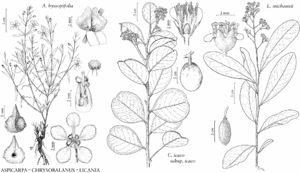familyChrysobalanaceae
genusChrysobalanus
Show Lower Taxa
Chrysobalanus
Sp. Pl. 1: 513. 1753.
Etymology: Greek chrysos, golden, and balanos, acorn or fruit, alluding to yellow fruits of some individuals of C. icaco
| Taxon | Illustrator ⠉ | |
|---|---|---|
 | Licania michauxii Chrysobalanus icaco subsp. icaco Aspicarpa hyssopifolia | Marjorie C. Leggitt Marjorie C. Leggitt Karin Douthit |
Shrubs or trees. Leaves persistent; blade margins entire. Thyrses axillary or terminal. Flowers: petals 5; stamens [12–] 14–22 [–26], filaments connate basally to 1/3 length in groups, densely hairy proximally; ovary densely hairy; styles densely hairy. Drupes globose or broadly ellipsoid; endocarp longitudinally ribbed. x = 11.
Distribution
Fla., Mexico, West Indies, Central America, South America, w Africa, in Pacific Islands, tropical and subtropical
Discussion
Species 4 (1 in the flora).
Selected References
None.
Lower Taxa
"/3" is not declared as a valid unit of measurement for this property.
... more about "Chrysobalanus"
connate +
hairy +
perigynous +
dehiscing +
versatile +
coriaceous +
developing +
Greek chrysos, golden, and balanos, acorn or fruit, alluding to yellow fruits of some individuals of C. icaco +
bisexual +
developed +
free +
hairy +
simple +
alternate +
persistent +
pinnate +
absent +
1[-3]-locular +
basal +
superior +
hairy +
anatropous +
perigynous +
distinct +
absent +
3-carpellate +
Sp. Pl. +
1753 +
distinct +
longitudinal +
14;22 +
absent +
basal +
hairy +
Chrysobalanus +
Chrysobalanaceae +
genus +
tardily deciduous;evergreen +